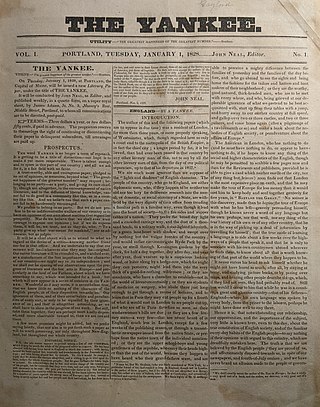
Charles Knight was an English publisher, editor and author. He published and contributed to works such as The Penny Magazine, The Penny Cyclopaedia, and The English Cyclopaedia, and established the Local Government Chronicle.

Letitia Elizabeth Landon was an English poet and novelist, better known by her initials L.E.L.

Lucy Larcom was an American teacher, poet, and author. She was one of the first teachers at Wheaton Female Seminary in Norton, Massachusetts, teaching there from 1854 to 1862. During that time, she co-founded Rushlight Literary Magazine, a submission-based student literary magazine which is still published. From 1865 to 1873, she was the editor of the Boston-based Our Young Folks, which merged with St. Nicholas Magazine in 1874. In 1889, Larcom published one of the best-known accounts of New England childhood of her time, A New England Girlhood, commonly used as a reference in studying antebellum American childhood; the autobiographical text covers the early years of her life in Beverly Farms and Lowell, Massachusetts.

Sir Samuel Egerton Brydges, 1st Baronet was an English bibliographer and genealogist. He was also Member of Parliament for Maidstone from 1812 to 1818.

A literary magazine is a periodical devoted to literature in a broad sense. Literary magazines usually publish short stories, poetry, and essays, along with literary criticism, book reviews, biographical profiles of authors, interviews and letters. Literary magazines are often called literary journals, or little magazines, terms intended to contrast them with larger, commercial magazines.

Alaric Alexander Watts was a British poet and journalist, born in London. His life was dedicated to newspaper creation and editing, and he was seen as a conservative writer. It led him to bankruptcy, when a pension was awarded to him by a friend, Lord Aberdeen.
Henry Colburn was a British publisher.

Lippincott's Monthly Magazine was a 19th-century literary magazine published in Philadelphia from 1868 to 1915, when it relocated to New York to become McBride's Magazine. It merged with Scribner's Magazine in 1916.

D. Appleton & Company was an American publishing company founded by Daniel Appleton, who opened a general store which included books. He published his first book in 1831. The company's publications gradually extended over the entire field of literature. It issued the works of contemporary scientists at moderate prices, for example, Herbert Spencer, John Tyndall, Thomas Huxley, Charles Darwin, etc. Medical books formed a special department, and books in the Spanish language for the South American market were a specialty which the firm made its own. In belles lettres and American history, it had a strong list of names among its authors.

The Gespensterbuch is a collection of German ghost stories written by August Apel and Friedrich Laun and published in five volumes between 1810 and 1815. The fifth volume was also published as the first volume of Apel and Laun's Wunderbuch (1815–1817), which served as a continuation of the Gespensterbuch series.
The Literary Gazette was a British literary magazine, established in London in 1817 with its full title being The Literary Gazette, and Journal of Belles Lettres, Arts, Sciences. Sometimes it appeared with the caption title, "London Literary Gazette". It was founded by the publisher Henry Colburn, who appointed the journalist and contributor William Jerdan as editor in July 1817. Jerdan wrote most of the articles and set the character of the magazine, and then became a shareholder and eventually the owner. He retired in 1850, and the magazine ceased publication in 1863.
Henry Davies was a Wales-born journalist, publisher and librarian at Cheltenham, England, who took an active part in the town’s political life, and edited the Cheltenham Looker-On for 57 years.
The New Monthly Magazine was a British monthly magazine published from 1814 to 1884. It was founded by Henry Colburn and published by him through to 1845.

David Lester Richardson was an officer of the East India Company, who throughout his life followed literary pursuits as a poet and periodical writer, and as editor and proprietor of literary journals. A skilled linguist, he was in later life an educator, serving as professor of English at Hindu College, where he inspired the Bengali poet Michael Madhusudan Dutta.
Robert Mudie (1777–1842) was a newspaper editor and author.

Thomas Medwin was an early 19th-century English writer, poet and translator. He is known chiefly for his biography of his cousin, Percy Bysshe Shelley, and for published recollections of his friend, Lord Byron.
Thomas Park (1759–1834) was an English antiquary and bibliographer, also known as a literary editor.

The Harvard Monthly was a literary magazine of Harvard University in Cambridge, Massachusetts, beginning October 1885 until suspending publication following the Spring 1917 issue.

The Yankee was one of the first cultural publications in the United States, founded and edited by John Neal (1793–1876), and published in Portland, Maine as a weekly periodical and later converted to a longer, monthly format. Its two-year run concluded at the end of 1829. The magazine is considered unique for its independent journalism at the time.












